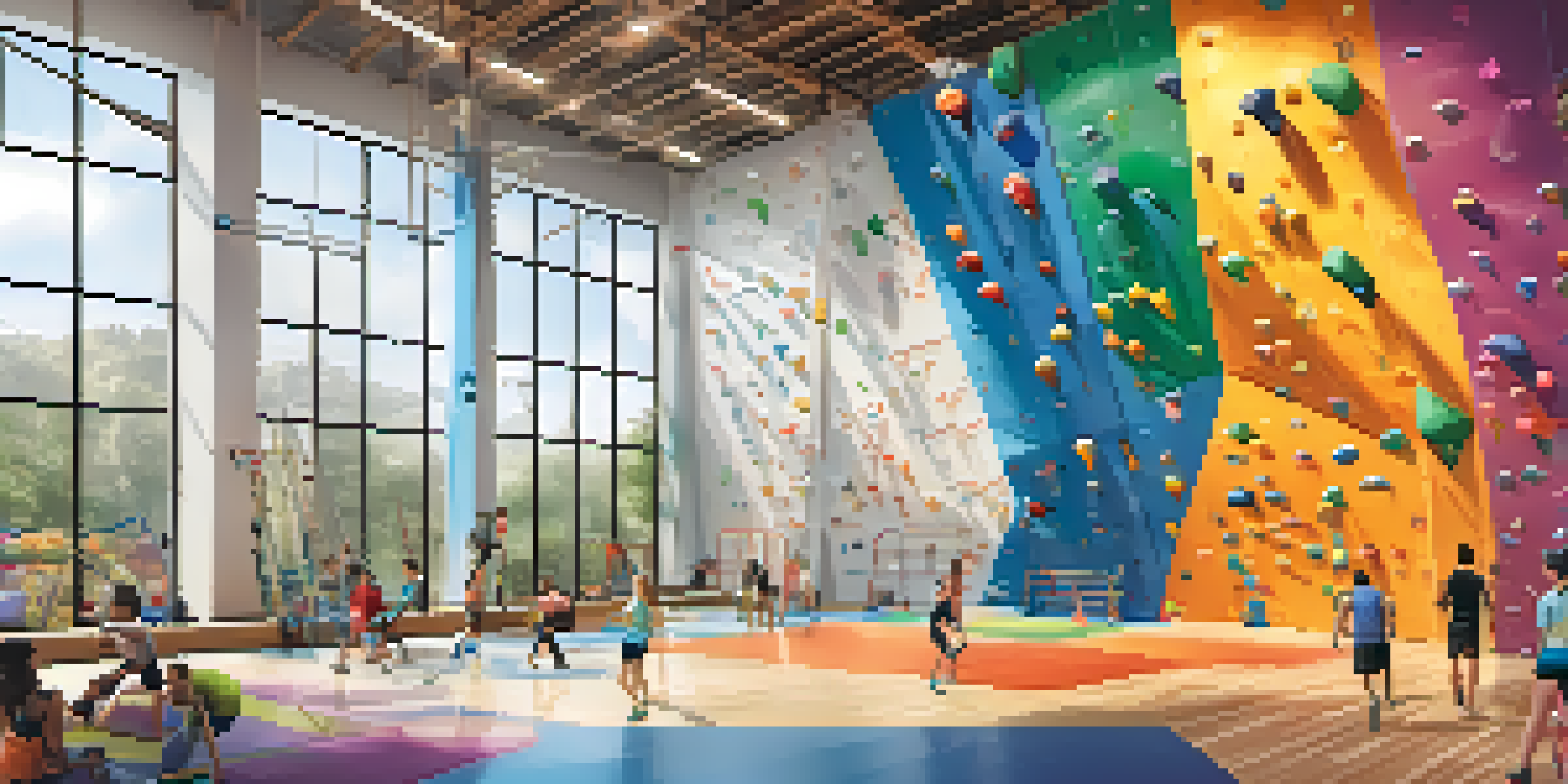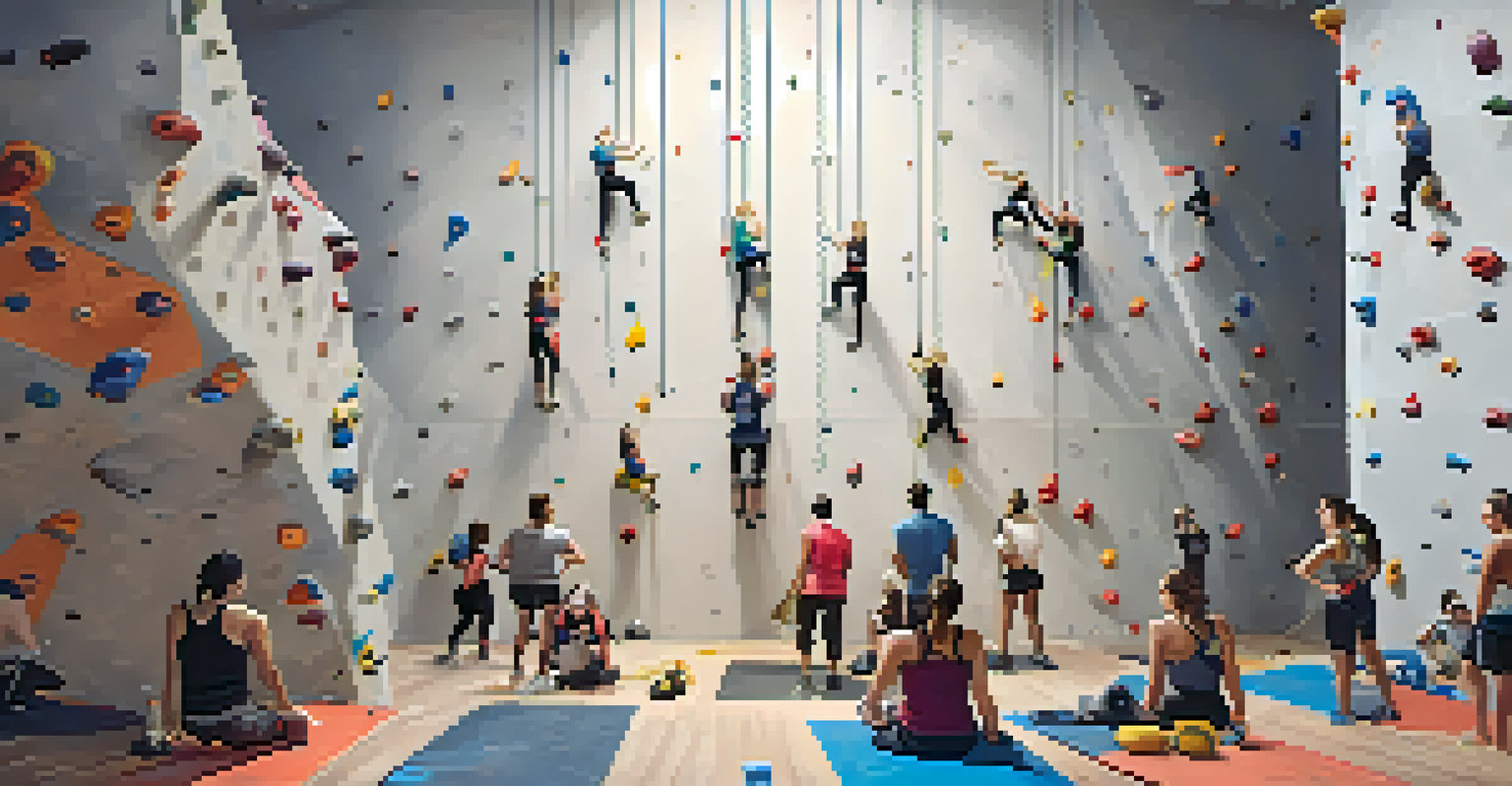Indoor Climbing Workouts: Combining Fun and Fitness

What Makes Indoor Climbing a Unique Workout Experience?
Indoor climbing is not just about scaling walls; it's a full-body workout that engages your muscles and mind. The thrill of reaching new heights keeps you motivated while you strengthen your arms, legs, and core. Unlike traditional workouts, climbing combines physical exertion with problem-solving, as you navigate routes that challenge your skills and endurance.
Climbing is not just a sport; it’s a way of life. It teaches you to overcome obstacles both on and off the wall.
The environment of an indoor climbing gym also contributes to its appeal. With colorful walls and various routes to explore, it feels more like an adventure than a workout. Many gyms offer community events and classes, creating a welcoming atmosphere that encourages climbers of all levels to participate and improve.
Moreover, the sense of accomplishment you feel after completing a challenging route is unmatched. Each climb serves as a personal milestone, pushing you to set and achieve new goals while having fun. This unique blend of excitement and achievement is what draws so many people to indoor climbing.
The Physical Benefits of Indoor Climbing Workouts
One of the most significant advantages of indoor climbing is its ability to build strength. As you pull yourself up various climbing holds, you're working multiple muscle groups simultaneously, from your forearms to your calves. Over time, you'll notice increased muscle tone and strength, making everyday activities feel easier.

Climbing also enhances your flexibility and balance. The dynamic movements required to navigate different routes force you to stretch and engage your core, improving your overall body coordination. This improvement can translate to other physical activities, giving you a well-rounded fitness routine.
Climbing Builds Strength and Endurance
Indoor climbing is a full-body workout that improves muscle strength, flexibility, and cardiovascular fitness.
Finally, indoor climbing is excellent for cardiovascular fitness. As you climb, your heart rate increases, providing a solid aerobic workout. This aspect makes indoor climbing not only a fun alternative to traditional cardio but also a way to improve overall heart health.
Mental Health Benefits of Climbing Workouts
Indoor climbing is a fantastic stress-reliever. The concentration required to plan your route and focus on each move helps take your mind off daily worries. As you ascend, you'll find a sense of flow that can be incredibly calming and meditative.
The best climber in the world is not necessarily the one who has the best technique, but the one who has the most determination.
Additionally, tackling climbing challenges can boost your self-confidence. Every time you conquer a new route, you build resilience and instill a sense of achievement. This growth mindset can extend beyond the climbing gym, positively impacting your personal and professional life.
Lastly, the social aspect of indoor climbing should not be overlooked. Many climbers form supportive communities, fostering friendships that encourage a sense of belonging. Sharing experiences and celebrating each other's successes can enhance your overall well-being.
How Indoor Climbing Can Enhance Your Overall Fitness
Indoor climbing offers a unique way to cross-train and diversify your fitness routine. By incorporating climbing into your weekly workouts, you can target muscles that traditional exercises might miss. This holistic approach can prevent injuries and keep your body balanced.
Moreover, the problem-solving aspect of climbing can keep your workouts engaging and fresh. Each route presents a new challenge, which helps combat workout boredom. This variety encourages consistency in your exercise routine, making it easier to stick to your fitness goals.
Mental Benefits of Indoor Climbing
Climbing promotes mental well-being by reducing stress, boosting self-confidence, and fostering a supportive community.
Lastly, climbing workouts can complement other fitness activities, such as running or weightlifting. By enhancing your strength, flexibility, and endurance through climbing, you'll likely see improvements in your performance across various sports and physical activities.
Getting Started: Tips for Beginners in Indoor Climbing
If you're new to indoor climbing, starting off on the right foot is essential. Begin by visiting a local climbing gym and asking for an orientation session. Many gyms offer beginner classes, providing you with fundamental skills and safety knowledge needed to climb confidently.
When you first start climbing, focus on mastering your technique rather than climbing the highest routes. Good footwork and body positioning can significantly enhance your climbing efficiency. Remember, it's not always about strength; sometimes, a well-placed foot can make all the difference.
Finally, don't hesitate to ask for help or advice from more experienced climbers. The climbing community is generally supportive and eager to share tips. Building relationships with fellow climbers can enhance your experience and motivate you to keep pushing your limits.
Safety Tips to Keep in Mind While Climbing Indoors
Safety should always be your top priority when climbing indoors. Ensure that you are familiar with the gym's safety protocols, including how to use harnesses, belay devices, and climbing ropes. Understanding how to properly secure yourself and your climbing partner can prevent accidents and injuries.
Before starting a climb, always check your gear and make sure everything is in good condition. A quick inspection can save you from potential mishaps. Additionally, take the time to learn how to fall safely, as falls can happen, even to the most experienced climbers.
Safety and Technique are Key
Prioritizing safety and focusing on proper technique are essential for beginners to enjoy indoor climbing effectively.
Lastly, listen to your body and know your limits. It's important to challenge yourself, but pushing too hard can lead to injuries. Pay attention to any signs of fatigue and take breaks when needed to ensure a safe and enjoyable climbing experience.
The Future of Indoor Climbing: Trends and Innovations
Indoor climbing is rapidly evolving, with technology playing a significant role in shaping the future of the sport. Innovative climbing walls equipped with interactive features, such as augmented reality, are emerging, providing climbers with exciting new challenges. These advancements can enhance your experience and keep you engaged.
Additionally, climbing gyms are increasingly focusing on community-building initiatives. From competitions to social events, gyms are creating spaces where climbers can connect and support one another. This trend not only fosters a sense of belonging but also encourages more people to try climbing as a fun fitness option.

Lastly, as climbing continues to gain popularity, we can expect more accessibility across various demographics. New gyms are opening up worldwide, making climbing available to people who may not have had the opportunity before. The future of indoor climbing looks bright, offering endless possibilities for fun and fitness.